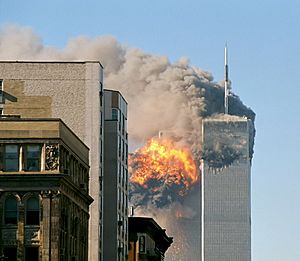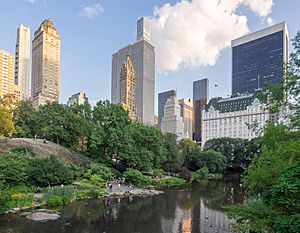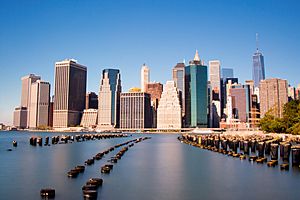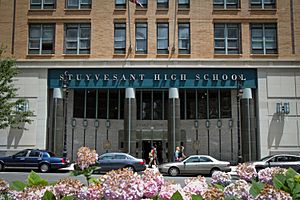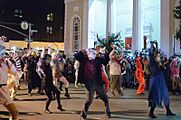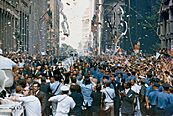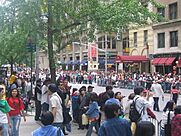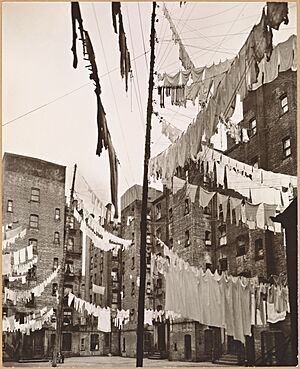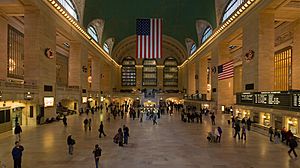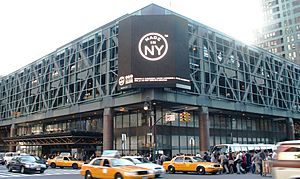Manhattan facts for kids
Quick facts for kids
Manhattan
New York County
|
|||
|---|---|---|---|
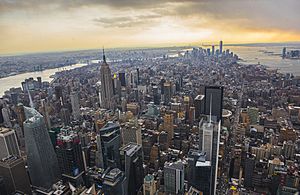
Midtown Manhattan, the world's largest central business district, in the foreground, with Lower Manhattan and its Financial District in the background
|
|||
|
|||
| Etymology: Likely ult. Lenape: Manaháhtaan ("the place where we get bows") | |||
| Nickname(s):
The City
|
|||
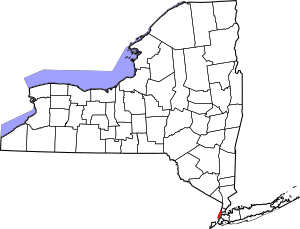
Map of Manhattan in New York
|
|||
| Country | |||
| State | |||
| County | New York County (coterminous) | ||
| City | New York City | ||
| Settled | 1624 | ||
| Government | |||
| • Type | Borough (New York City) | ||
| Area | |||
| • Total | 33.59 sq mi (87.0 km2) | ||
| • Land | 22.83 sq mi (59.1 km2) | ||
| • Water | 10.76 sq mi (27.9 km2) 32% | ||
| Dimensions
—width at 14th Street, widest
|
|||
| • Length | 13 mi (21 km) | ||
| • Width | 2.3 mi (3.7 km) | ||
| Highest elevation | 265 ft (81 m) | ||
| Population
(2020)
|
|||
| • Total | 1,694,250 | ||
| • Estimate
(2022)
|
1,596,273 | ||
| • Density | 74,781.6/sq mi (28,873.3/km2) | ||
| Demonyms | Manhattanite Knickerbocker (historical, poetic) |
||
| GDP | |||
| • Total | 5.652 billion (2022) · 2nd by U.S. county; 1st per capita | ||
| Time zone | UTC−05:00 (EST) | ||
| • Summer (DST) | UTC−04:00 (EDT) | ||
| ZIP Code format |
100xx, 101xx, 102xx
|
||
| Area code | 212/646/332, 917 | ||
Manhattan is the smallest and most crowded of the five boroughs that make up New York City. It's also known as New York County. Manhattan is almost entirely on an island. It's the heart of New York City's economy and government. Many people call it the world's capital for culture, money, media, and entertainment.
Manhattan was originally home to the Lenape people. Europeans, specifically the Dutch, started a trading post here in 1624. They called it New Amsterdam. In 1664, the English took control and renamed it New York. From 1785 to 1790, New York served as the capital of the United States. The Statue of Liberty in New York Harbor welcomed millions of immigrants. It became a symbol of the United States. Manhattan became a borough in 1898. The Harlem Renaissance in the 1920s made Harlem a center for African-American culture. The Stonewall Inn in Greenwich Village is famous for important protests for equal rights in 1969. Manhattan was also the site of the World Trade Center, which was destroyed in the terrorist attacks of 2001.
Manhattan is surrounded by the Hudson River, East River, and Harlem River. It also includes smaller islands like Roosevelt Island. The main island is split into three parts: Lower Manhattan, Midtown, and Upper Manhattan. It's one of the most crowded places on Earth. In 2020, about 1.7 million people lived there.
Manhattan is home to Wall Street and two of the world's biggest stock exchanges. Many global media companies, colleges, and universities are here. The headquarters of the United Nations is in Midtown Manhattan. Three of the world's most visited places are in Manhattan: Times Square, Central Park, and Grand Central Terminal. Fifth Avenue is known for its expensive shops. Manhattan also has many famous skyscrapers like the Empire State Building. It's home to the New York Knicks (basketball) and New York Rangers (hockey) teams.
Contents
A Look Back in Time
Early Settlements
Manhattan was originally part of the Lenape people's land. They were Native American tribes like the Munsee and Wappinger. They had several settlements and trails, including one that became Broadway. The name Manhattan comes from the Lenape language. It means "the place where we get bows" or "place for gathering wood to make bows."
Colonial Days
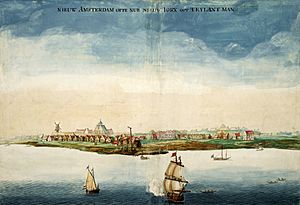
In 1524, an explorer named Giovanni da Verrazzano was the first European to visit the area. Henry Hudson mapped Manhattan Island in 1609. He saw the native people living there. A Dutch fur trading settlement started in 1624 on Governors Island. In 1625, the Dutch began building Fort Amsterdam on Manhattan Island. This fort was later called New Amsterdam. This is considered the start of New York City.
In 1664, English forces took over New Netherland. They renamed it "New York" after the Duke of York. The Dutch briefly took it back in 1673. But they gave it back to England for good in 1674.
American Revolution and Early United States
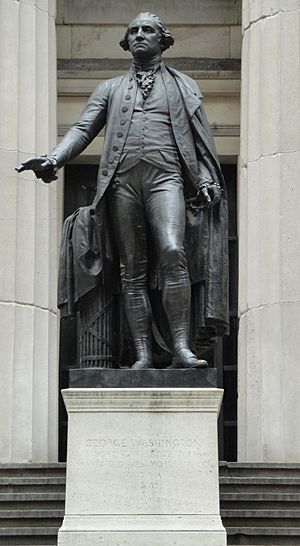
Manhattan was a key place during the American Revolutionary War. The American army had to leave Manhattan in 1776. The British then used the city as their main base. British rule ended on November 25, 1783. This day is celebrated as Evacuation Day.
New York City was the capital of the United States from 1785 to 1790. This was first under the Articles of Confederation. Then it was the first capital under the new U.S. Constitution. Important events happened at Federal Hall. The Supreme Court met there for the first time. The Bill of Rights was also created there.
Growth in the 1800s
New York grew into a major economic center. By 1810, it was the most populated city in the U.S. The Commissioners' Plan of 1811 created Manhattan's famous grid of streets. The Erie Canal opened in 1825. This made it much cheaper to transport goods. It connected New York's port to markets in the Midwest and Canada.
Central Park opened its first parts in 1858. It was the first large public park in an American city. New York City had strong business ties to the South. But during the American Civil War, there were big protests and civil disorder in 1863. After the war, many immigrants came to Manhattan. The Statue of Liberty was dedicated in 1886. It welcomed millions seeking a new life.
In 1883, the Brooklyn Bridge opened. It connected Manhattan to Brooklyn. In 1898, New York City became one big city. Manhattan became one of its five boroughs.
The 1900s and Beyond
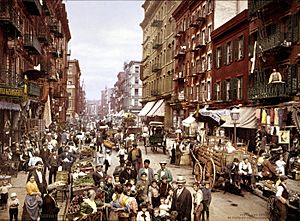
The New York City Subway opened in 1904. It helped connect the new city. New bridges also linked Manhattan to Brooklyn and Queens. In the 1920s, many African Americans moved to Harlem. This led to the Harlem Renaissance, a time of great cultural growth. New skyscrapers were built, like the Woolworth Building and Empire State Building.
A tragic fire at the Triangle Shirtwaist Factory in 1911 killed many workers. This led to important changes in fire safety and workplace rules. Even during the Great Depression, more tall buildings were finished. After World War II, new housing was built. The United Nations moved its headquarters to Manhattan in 1952.
In 1969, the Stonewall riots happened in Greenwich Village. These were important protests for equal rights. In the 1970s, New York City faced economic problems. But the financial industry grew again in the 1980s. Wall Street became a global financial center. By the late 1990s, areas like Times Square were cleaned up and became popular tourist spots. New tech companies also started to grow.
Manhattan in the 21st Century
On September 11, 2001, the Twin Towers were destroyed in terrorist attacks. This caused a lot of damage and sadness. Since then, much of Lower Manhattan has been rebuilt. The new One World Trade Center opened in 2014. It is the tallest building in the Western Hemisphere.
In 2011, the Occupy Wall Street protests began. These protests in Lower Manhattan gained global attention. They were about social and economic fairness. In 2012, Hurricane Sandy caused major damage. It brought flooding and power outages. This led to talks about building barriers to protect the city from future storms.
Exploring Manhattan's Geography
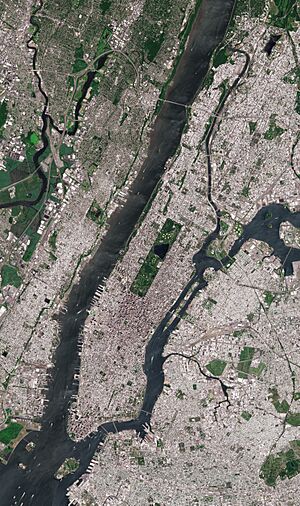
Manhattan is about 22.8 square miles of land. It is 13.4 miles long and 2.3 miles wide at its widest point. The borough is mostly Manhattan Island. It also includes the Marble Hill neighborhood and several small islands. These include Randalls and Wards Island and Roosevelt Island.
Manhattan Island's Sections
Manhattan Island is generally divided into three main parts. These are Downtown (Lower Manhattan), Midtown (Midtown Manhattan), and Uptown (Upper Manhattan). Fifth Avenue runs down the middle, separating the East Side and West Side. The Hudson River is to the west. The East River is to the east. The Harlem River separates Manhattan Island from the Bronx to the north.
Over time, new land has been created. For example, Battery Park City was built on land reclaimed from the Hudson River.
Marble Hill: A Unique Spot
Marble Hill used to be part of Manhattan Island. But a canal was dug in 1895 to connect the Harlem and Hudson rivers. This separated Marble Hill from the rest of Manhattan. Later, the old river channel was filled in. Now, Marble Hill is connected to the mainland. It is still part of Manhattan borough and New York County.
Smaller Islands of Manhattan
Manhattan includes several smaller islands. In New York Harbor, there are:
- Ellis Island (shared with New Jersey)
- Governors Island
- Liberty Island (where the Statue of Liberty stands)
In the East River, there are:
- Randalls and Wards Islands (joined together)
- Mill Rock
- Roosevelt Island, which has about 14,000 residents.
- U Thant Island
Manhattan's Strong Foundations
The ground under Manhattan is made of strong rock. This includes marble, gneiss, and schist. This strong bedrock is perfect for building the foundations of Manhattan's many skyscrapers.
Neighboring Areas
Manhattan's Climate
New York City has a climate with warm, humid summers and cold, damp winters. Spring and autumn are usually mild. The city gets a good amount of sunshine each year. It also gets about 50 inches of rain annually. Snowfall varies each winter.
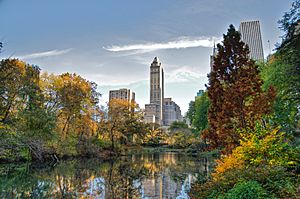
Discovering Manhattan's Neighborhoods
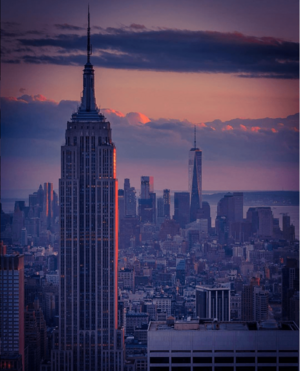
Manhattan has many neighborhoods, each with its own feel. Their names come from different things. Some are based on geography, like the Upper East Side. Others describe the people who live there, like Little Italy. Some names are acronyms, like TriBeCa (TRIangle BElow CAnal Street) or SoHo (SOuth of HOuston).
Neighborhoods like SoHo are known for shopping and homes. Greenwich Village and the East Village have a history of artistic and bohemian culture. Chelsea is a center for art and nightlife. Chinatown has the largest group of Chinese people outside of Asia. Koreatown is around 32nd Street. Washington Heights is home to many Dominican immigrants. Harlem is a historic center of African American culture.
Manhattan has two main business areas. These are the Financial District downtown and Midtown Manhattan. "Uptown" usually means the northern part of Manhattan. "Downtown" means the southern part. "Midtown" is in between. Fifth Avenue generally divides the East Side from the West Side.
Manhattan's Famous Skyline
Manhattan's unique skyline is famous for its skyscrapers. Buildings like the Chrysler Building and the Empire State Building are symbols of New York. The Empire State Building alone gets about 4 million visitors each year. Older buildings like the Equitable Building led to rules about how tall buildings could be built. These rules made buildings have "setbacks" as they rose. This was to make sure sunlight could still reach the streets below.
The demolition of the old Penn Station in the 1960s was a big loss. It led to the creation of the New York City Landmarks Preservation Commission. This group helps protect the city's historic buildings. A new Moynihan Train Hall opened in 2021. It is a modern addition to the Penn Station area.
National Protected Areas
Manhattan has several national historic sites and monuments:
- African Burial Ground National Monument
- Castle Clinton National Monument
- Federal Hall National Memorial
- General Grant National Memorial
- Governors Island National Monument
- Hamilton Grange National Memorial
- Lower East Side Tenement National Historic Site
- Statue of Liberty National Monument (part)
- Theodore Roosevelt Birthplace National Historic Site
Green Spaces: Parks in Manhattan
Parks cover about 18% of Manhattan's land. Central Park is the largest park, covering 840 acres. It was designed by Frederick Law Olmsted and Calvert Vaux. The park has walking paths, ice-skating rinks, and playgrounds. It also has a road where cars have been banned since 2018. Central Park looks natural, but it was entirely designed and built.
Other major parks in Manhattan include:
- Bowling Green
- Bryant Park
- City Hall Park
- DeWitt Clinton Park
- East River Greenway
- Fort Tryon Park
- Fort Washington Park
- Harlem River Park
- Rucker Park
- Imagination Playground
- Inwood Hill Park
- Isham Park
- J. Hood Wright Park
- Jackie Robinson Park
- Madison Square Park
- Marcus Garvey Park
- Morningside Park
- Randall's Island Park
- Riverside Park
- Sara D. Roosevelt Park
- Seward Park
- St. Nicholas Park
- Stuyvesant Square
- The Battery
- The High Line
- Thomas Jefferson Park
- Tompkins Square Park
- Union Square Park
- Washington Square Park
Manhattan's Economy
Manhattan is a huge economic center for New York City. Most workers in Manhattan have "white-collar" jobs, meaning they work in offices. Many people commute into Manhattan for work every day. Manhattan has one of the highest average incomes in the U.S. However, there is also a big gap between the richest and poorest residents. Living in Manhattan is very expensive.
Financial Powerhouse
Manhattan is a global leader in finance. It's home to Wall Street, a famous financial center. The New York Stock Exchange (NYSE) and the Nasdaq are both here. These are two of the world's largest stock exchanges.
Home to Major Companies
New York City has the most company headquarters in the U.S. Most of these are in Manhattan. Midtown Manhattan has the largest central business district in the world. Manhattan is also known for its advertising industry, often called "Madison Avenue."
Tech and Science Growth
Manhattan is a major hub for high technology. This includes areas like artificial intelligence, internet companies, and financial technology. Many tech startups are growing here. The city is also strong in biotechnology. This field uses science to create new products, especially in medicine. Universities and research centers in Manhattan help this sector grow.
Tourism: A Big Draw
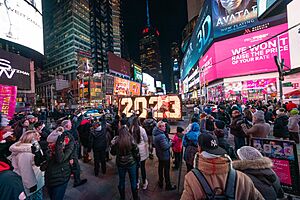
Tourism is very important to Manhattan's economy. Millions of people visit the city each year. They come to see famous landmarks and shows. Broadway shows sell billions of dollars in tickets each year.
Real Estate: Very Valuable
Manhattan has some of the most expensive real estate in the world. Homes here cost a lot per square foot. Some of the tallest residential buildings in the world are in Midtown Manhattan.
Media Center
Manhattan is a global media capital. Many news outlets, TV channels, and radio stations are based here. Major newspapers like The New York Times and The Wall Street Journal have their headquarters in Manhattan.

All four major American TV networks (ABC, CBS, NBC, Fox) are in Manhattan. Many cable channels like CNN and MTV are also here. Manhattan also has many radio stations, including those focused on hip-hop and public radio.
Education in Manhattan
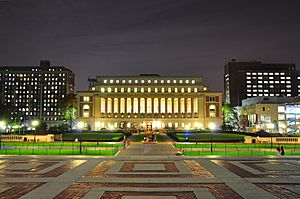
Manhattan has many public and private schools. The New York City Department of Education runs the public schools. There are also many well-known public high schools. These include Stuyvesant High School and Fiorello H. LaGuardia High School. Many private schools are also located here.
Most adults in Manhattan have a college degree. Many have advanced degrees too. Manhattan is home to many colleges and universities. Some famous ones are Columbia University, New York University (NYU), and The Juilliard School. The City University of New York (CUNY) is a large public university system. It has several campuses in Manhattan.
Manhattan is also a world leader in medical education and research. Many top medical centers and research institutions are here. The New York Public Library serves Manhattan. It has one of the largest library collections in the country. There are many branch libraries throughout the borough.
Manhattan's Culture
Manhattan is often seen as the heart of New York City's culture. It has been central to many important cultural movements. The Harlem Renaissance in the 1920s was a major period for African-American literature and art. In the 1950s and 60s, Manhattan was a center for the pop art movement.
Broadway theater is the highest level of professional theater in the U.S. Plays and musicals are performed in theaters around Times Square. Lincoln Center for the Performing Arts is home to many famous arts groups. These include the Metropolitan Opera and the New York Philharmonic.
Manhattan has some of the world's best art collections. These include the Metropolitan Museum of Art, the Museum of Modern Art (MoMA), and the Guggenheim Museum. Many art galleries are found on the Upper East Side and in Chelsea.
Manhattan is a very important place for equal rights. The 1969 Stonewall Riots started the modern movement for equal rights. The annual NYC Pride March in June is the largest pride parade in the world. It attracts millions of people.
Manhattan is known for many famous sayings. "New York minute" means a very short time. The term "melting pot" was first used to describe the diverse immigrant neighborhoods on the Lower East Side. The "Big Apple" nickname started in the 1920s. It became popular to describe New York City as a major world capital.
Manhattan is famous for its many street parades. These celebrate holidays, different cultures, and human rights. The Macy's Thanksgiving Day Parade is the world's largest parade. It draws millions of viewers. Other big parades include the St. Patrick's Day Parade and the Greenwich Village Halloween Parade. New York Fashion Week is also a major event in Manhattan.
Sports in Manhattan
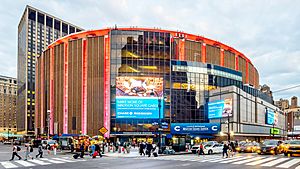
Manhattan is home to the New York Knicks (NBA basketball) and the New York Rangers (NHL hockey). Both teams play their home games at Madison Square Garden. This is the only major professional sports arena in the borough.
Manhattan used to have professional baseball teams. The original New York Giants and the New York Yankees both played here. But they later moved to other boroughs or states. Today, New York City's football teams play in New Jersey.
Rucker Park in Harlem is a famous playground court. Many NBA players have played "streetball" there. The first national college basketball championship was held in New York in 1938.
Housing in Manhattan
Around the 1900s, many immigrants lived in crowded, unhealthy tenement buildings. New housing rules later stopped the building of these types of homes. Manhattan has many private homes and apartments. It also has public housing managed by the New York City Housing Authority (NYCHA).
Manhattan has the highest average rent cost of any county in the U.S. Its luxury housing market is one of the most expensive in the world.
Getting Around Manhattan
Public Transportation
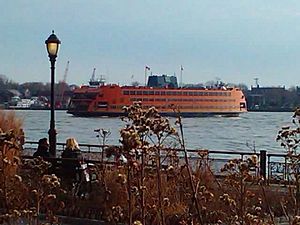
Manhattan residents use public transportation a lot. Most people here take public transport to work. The New York City Subway is the main way to travel. It has 151 stations in Manhattan. The PATH system connects Manhattan to New Jersey.
Commuter trains also serve Manhattan. The Long Island Rail Road (LIRR) connects to Long Island. The Metro-North Railroad goes to Upstate New York and Connecticut. NJ Transit trains go to New Jersey. The new East Side Access project brings LIRR trains to Grand Central Terminal.
New York City Transit also has many local and express buses. The Roosevelt Island Tramway is a cable car system. It takes people between Roosevelt Island and Manhattan. The Staten Island Ferry is free. It carries millions of passengers between Manhattan and Staten Island every year. New ferry routes have also opened across the city.
Penn Station and Grand Central Terminal are the busiest train stations in the U.S. They serve many commuter lines. Amtrak provides train service to other cities from Penn Station. The Port Authority Bus Terminal is the world's busiest bus station. It serves many intercity buses.
Roads and Streets
Manhattan has a grid plan of streets. There are numbered "avenues" running north and south. These include First Avenue to Twelfth Avenue. There are also lettered avenues like Avenue A. Numbered streets run east and west. Major streets like 34th, 42nd, and 57th are wider.
Broadway is a famous street that cuts diagonally across the grid. It creates well-known intersections like Times Square. Driving across Manhattan can be slow due to traffic. There are no major express roads through the middle of the island.
A cool event called Manhattanhenge happens twice a year. The sunset lines up perfectly with the east-west streets. This creates a beautiful view.
Major highways like the FDR Drive and Henry Hudson Parkway run along the edges of Manhattan.
Bridges, Tunnels, and Ferries
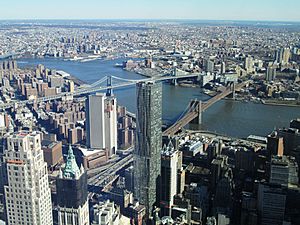
Manhattan is an island, so it needs many connections to other places. The George Washington Bridge connects Manhattan to New Jersey. The Holland Tunnel and Lincoln Tunnel also link Manhattan to New Jersey under the Hudson River.
There are many bridges to the Bronx over the Harlem River. Five major bridges cross the East River to connect Manhattan to Long Island. These include the Ed Koch Queensboro Bridge, Williamsburg Bridge, Manhattan Bridge, and Brooklyn Bridge.
Other tunnels connect Manhattan to other boroughs. The Queens–Midtown Tunnel goes to Queens. The Brooklyn–Battery Tunnel connects Lower Manhattan to Brooklyn.
Several ferry services also operate between New Jersey and Manhattan.
Heliports
Manhattan has three public heliports. These are for helicopters. They are located on East 34th Street, Downtown Manhattan/Wall Street, and West 30th Street.
Utilities and Services
Manhattan gets its gas and electricity from Consolidated Edison. It also has the world's largest district steam system. This provides steam for heating and hot water. Cable service is provided by Time Warner Cable. Telephone service is mainly from Verizon Communications.
The New York City Department of Sanitation handles garbage removal. Most of the city's trash is sent to large dumps outside the city. New York City uses many clean-air hybrid buses and taxis.
Clean Water Supply
New York City gets its drinking water from a protected watershed in the Catskill Mountains. This natural system helps keep the water very clean. New York is one of the few major U.S. cities where most drinking water doesn't need extra treatment. Water comes to Manhattan through large tunnels.
See also
 In Spanish: Manhattan para niños
In Spanish: Manhattan para niños









